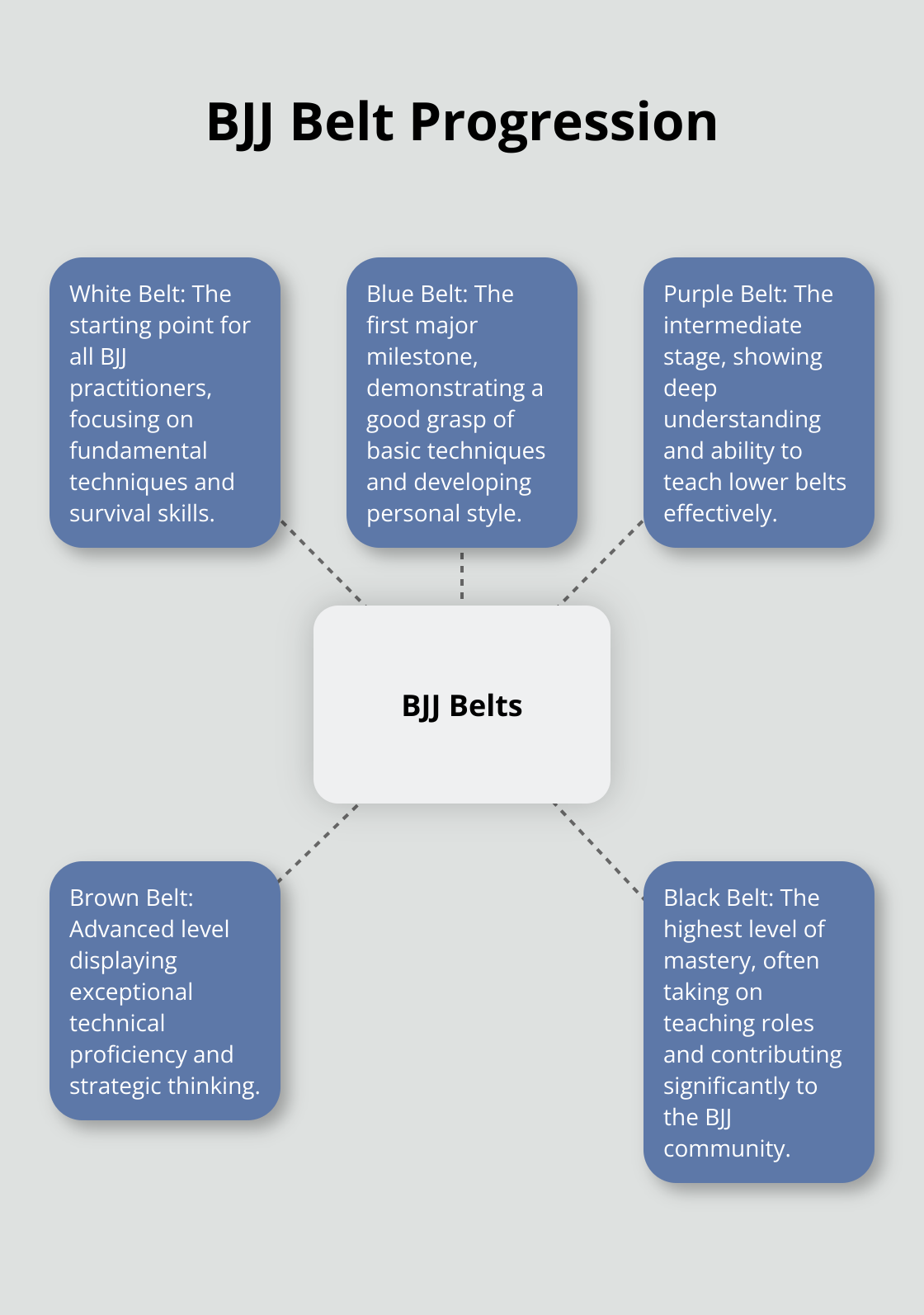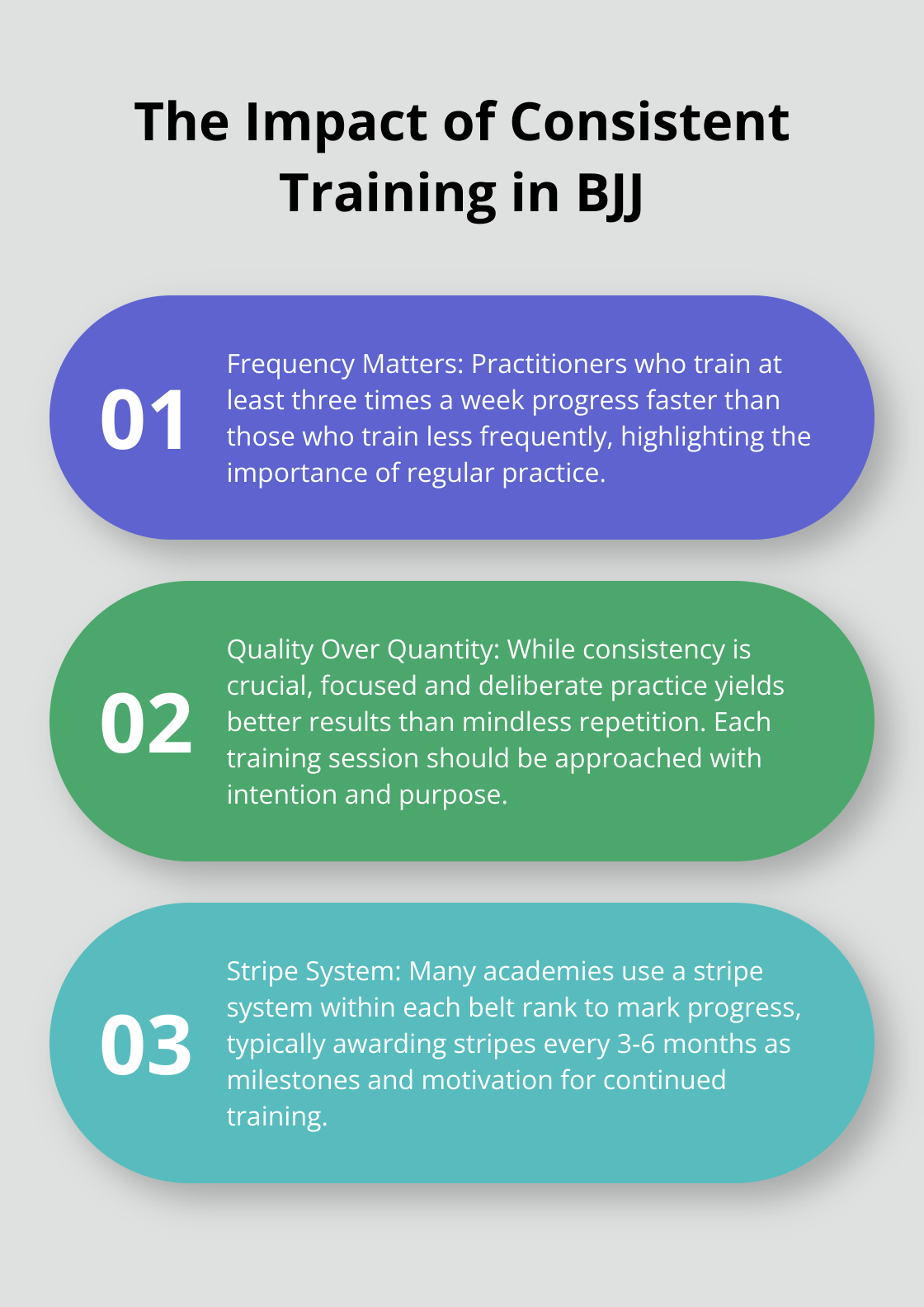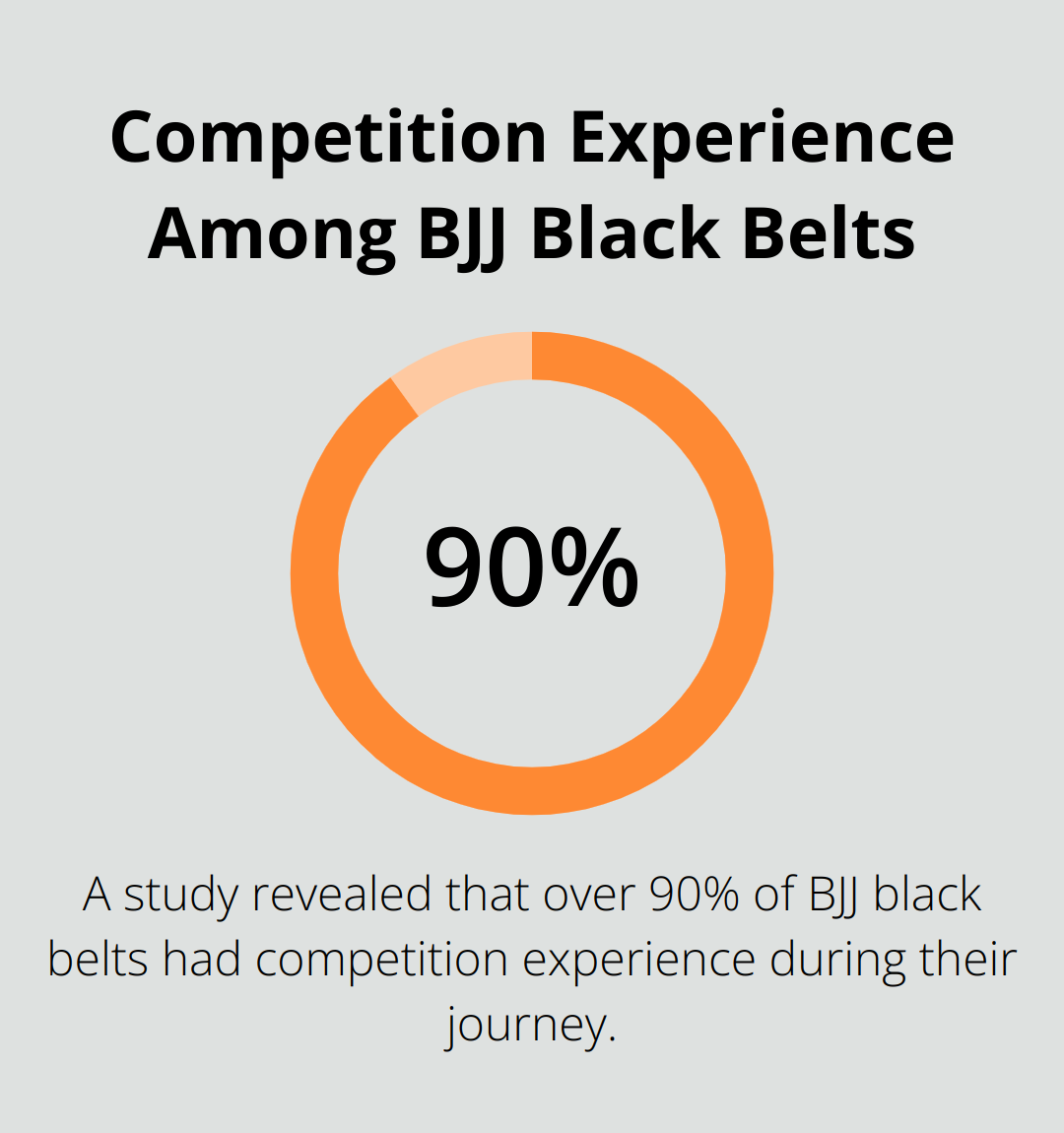At Jiu jitsu, we know that Brazilian Jiu-Jitsu belts are more than just colorful accessories. They represent a practitioner’s skill level, dedication, and journey in the art.
Our comprehensive guide will walk you through the intricacies of BJJ rankings, from white to black belt and beyond.
We’ll explore promotion requirements, address controversies, and highlight the true essence of BJJ: personal growth and continuous improvement.
What Are the BJJ Belt Colors?
Brazilian Jiu-Jitsu (BJJ) uses a belt system to indicate a practitioner’s skill level and experience. This system consists of five main adult belt colors: white, blue, purple, brown, and black. Each belt represents a significant milestone in a BJJ practitioner’s journey.

White Belt: The Foundation
The white belt marks the starting point for all BJJ practitioners. At this level, students learn fundamental techniques, basic positions, and survival skills. During this period, they develop a solid foundation in BJJ principles and understand the importance of technique over strength.
Blue Belt: The First Major Milestone
Blue belt often represents the first major achievement in BJJ. Students typically reach this level after consistent training. Blue belts demonstrate a good grasp of basic techniques and start to develop their own style. They execute submissions and escapes with increasing proficiency and begin to understand the strategic aspects of BJJ.
Purple Belt: The Intermediate Stage
Purple belt serves as the middle ground between beginner and advanced levels. At this stage, BJJ practitioners show a deep understanding of techniques and often teach lower belts effectively. They also develop more advanced strategies and combinations.
Brown and Black Belts: Advanced Mastery
Brown and black belts represent the highest levels of mastery in BJJ. These practitioners display exceptional technical proficiency, strategic thinking, and a profound understanding of BJJ principles. They frequently take on teaching roles and contribute significantly to the BJJ community.
The journey through these belt ranks involves more than just technical skill. It encompasses personal growth, dedication, and contribution to the BJJ community. While the time spent at each belt varies widely (depending on factors such as training frequency and individual progress), the focus should always remain on continuous improvement rather than rushing through the ranks.
As practitioners progress through the belt system, they face new challenges and opportunities for growth. The next section will explore the specific requirements for BJJ belt promotions, shedding light on the technical skills and knowledge expected at each level.
What Does It Take to Earn a BJJ Belt?
Technical Proficiency and Knowledge
Brazilian Jiu-Jitsu belt promotions require a combination of skill development, dedication, and perseverance. To advance in BJJ, practitioners must demonstrate a solid grasp of techniques appropriate for their current level. White belts focus on survival and escapes, while blue belts execute basic submissions and positional control. As practitioners progress to purple and brown, their arsenal expands to include more complex techniques and combinations.
The International Brazilian Jiu-Jitsu Federation (IBJJF) sets minimum time requirements between belt promotions. For instance, it takes at least two years to progress from white to blue belt. However, time alone doesn’t suffice; practitioners must show proficiency in applying techniques during live rolling sessions.
Consistency: The Key to Progress
Regular training plays a crucial role in belt advancement. A survey of BJJ practitioners reveals that those who train at least three times a week progress faster than those who train less frequently. Consistency helps ingrain techniques into muscle memory and develops the conditioning necessary for higher-level performance.

Many academies use a stripe system within each belt rank to mark progress. These stripes (typically awarded every 3-6 months) serve as milestones and motivation for continued training. Quality of training often trumps quantity – focused, deliberate practice yields better results than mindless repetition.
The Impact of Competition
While not mandatory at all schools, competition experience can significantly influence belt promotions. Competing allows practitioners to test their skills against resisting opponents outside their regular training partners. It also demonstrates the ability to perform under pressure – a valuable trait as practitioners advance in rank.

A study of BJJ black belts revealed that over 90% had competition experience during their journey. However, competition success isn’t the only factor. Many instructors value a student’s ability to apply techniques effectively in various scenarios, whether in competition or during regular training.
Beyond Technical Skills
Earning a BJJ belt transcends technical skills. It reflects a practitioner’s dedication to the art, ability to apply knowledge under pressure, and contribution to the BJJ community. As practitioners progress through the ranks, they should focus on consistent improvement rather than rushing towards the next belt color.
At Souza Grappling Co., we encourage our students to compete but recognize that it’s not for everyone. We consider a practitioner’s overall growth, including their ability to help lower-ranked students and contribute positively to the academy’s culture.
The journey to earn a BJJ belt is unique for each practitioner, shaped by individual experiences, challenges, and growth. This personal nature of advancement often leads to discussions and debates within the BJJ community about the fairness and consistency of belt promotions. Let’s explore these controversies in the next section.
Why Are BJJ Belt Rankings Controversial?
The Subjectivity of Promotions
The Brazilian Jiu-Jitsu belt system faces criticism due to the subjective nature of promotions. Unlike martial arts with standardized testing, BJJ promotions often depend on an instructor’s judgment. This subjectivity can lead to inconsistencies and perceived unfairness.
A study examines the martial art of Brazilian Jiu-Jitsu and its ability to build the six core competencies of resilience as well as increase personal growth. This research highlights the importance of focusing on skill development and personal improvement rather than solely on belt rankings.
Variations Across Academies
Significant discrepancies exist in promotion standards between different academies and associations. What one school considers blue belt level might qualify as purple belt level in another. This inconsistency becomes problematic when practitioners switch academies or compete against others from different schools.
The International Brazilian Jiu-Jitsu Federation (IBJJF) has attempted to standardize promotion requirements. However, not all academies adhere strictly to these guidelines. For example, the IBJJF recommends a minimum of two years at white belt before promotion to blue, but some schools promote students much faster (sometimes in as little as six months).
The Debate Over Belt Value
The value of belt ranks in BJJ sparks heated discussions. Critics argue that the focus on belt color can detract from the true essence of the art: personal growth and skill development. This emphasis can lead to “belt chasing,” where practitioners prioritize promotions over genuine improvement.
Impact on Training Culture
The controversy surrounding belt rankings can affect the overall training culture in BJJ academies. Some practitioners become overly focused on achieving the next belt, potentially neglecting the importance of technique refinement and personal growth.
This fixation on rank can create an unhealthy competitive atmosphere within academies, where students compare themselves to others based on belt color rather than skill level. Such an environment may discourage beginners and hinder the collaborative learning process that is fundamental to BJJ.
Addressing the Controversies
To mitigate these issues, many academies (including Souza Grappling Co.) try to maintain a balanced approach. They emphasize skill development and personal growth over belt color, while still acknowledging the ranking system’s importance as a motivational tool and progress measure.
Instructors can help by clearly communicating promotion criteria and encouraging students to focus on their individual journeys rather than comparing themselves to others. This approach fosters an environment of continuous learning and improvement, which preserves the positive aspects of belt rankings while minimizing their negative impacts.
Final Thoughts
The Brazilian Jiu-Jitsu belt system marks milestones in a practitioner’s journey and motivates continued growth. However, the true essence of BJJ lies not in belt colors, but in personal development and acquired skills. The path to earning Brazilian Jiu-Jitsu belts requires dedication, perseverance, and continuous learning.
At Souza Grappling Co., we encourage students to embrace the BJJ journey and value every training session. Our state-of-the-art facility provides an ideal environment for practitioners of all levels to hone their skills. We strive to foster a supportive community where individuals can build confidence and improve themselves.
The ultimate goal in BJJ extends beyond achieving a certain belt color. It involves becoming the best version of yourself both on and off the mat. Whether you’re a white belt or a black belt, BJJ offers endless opportunities for growth and self-improvement (regardless of your current rank).




